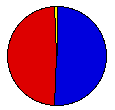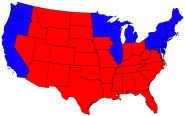According to a recent opinion poll, a large majority of people around the world consider the USA to be the single biggest threat to world peace today. Such a turn-around after the outpouring of emotion and sympathy following the Sept 11 mass-murders.
As a result of the President Bush's foreign policies, driven by dreams of empire by the grandiosely-named Project For The New American Century and the neo-conservative movement (a misnomer if there ever was one: neo-cons are not conservative, they are politically and religiously radical to a frightening extent), a vast number of people across the world have a cynical, jaded, and sometimes hostile opinion of Americans:
- Those damned Americans -- if they weren't already completely radicalised, after September 11 they sure are now. If they aren't personally driving around in Hummers with guns, yelling 'Yee Haw!' and shooting poor blacks and Arabs, they're sitting in expensive Washington or New York offices, doing deals with some general to send the fighter planes to bomb civilians somewhere far away.
If you are like most people, the above thoughts have crossed your mind. If you are sensible, you'll recognise it as an unfair generalisation, an ugly stereotype.
But there is certainly an huge element of truth to the stereotype. For the last 30 years, successive American governments -- yes, even the liberals' darling, Bill Clinton -- have cut services and safety nets to the poor, allowed corporations to dump toxic waste in the water we drink and air we breathe, dropped bombs on civilians, broken international agreements, and generally acted like the world was their oyster. (And remember: oysters are generally eaten alive.)
And then there are those electoral maps we keep seeing, showing vast tracts of the USA painted red, and only a few tiny corners in blue: huge expanses of the country voting Red, supporting politicians who stand for more arsenic in the drinking water, pension cuts for veterans, more tax breaks for the rich and fewer safety nets for the poor... if they're not yee-haws, what are they thinking?
Has the USA has become a nation of extremist radicals?
But no, that's no more true for the USA than it is for any other country. Sure, virulent nationalism is strong in the USA, but the country has not turned as red as those maps show. The maps are strongly misleading.
John Rogers of Kung Fu Monkey talks about the red versus blue maps:
Unfortunately, the Red State/Blue State narrative also happens to be monstrously destructive, culturally. Painting massive swaths of the country one color (be it red or blue), while ignoring the actual number of voters in each state completely distorts the actual political balance in this country -- specifically, how moderate most of the country is.
It empowers fundamentalists of all stripes, because visual cues are enormously powerful and that color dichotomy implants resonances of ideological dichotomy that affect the framework through which the media present information and we to a great degree perceive it, then fix it into our own world-view, our mental operating system.
Those maps of red states and blue states not only don't tell the true story, they tell a false story. As Rogers points out, this:

is not the same as this:

Mark Newman of the University of Mitchigan has more information about the distribution of votes in the last few US elections. He says:
[...] we know that nationwide the percentages of voters voting for either candidate were almost identical, so what is going on here?
The answer seems to be that the amount of red on the map is skewed because there are a lot of counties in which only a slim majority voted Republican. One possible way to allow for this, suggested by Robert Vanderbei at Princeton University, is to use not just two colors on the map, red and blue, but instead to use red, blue, and shades of purple to indicate percentages of voters.
When you do that, as Newman does here, you don't get red and blue states. You get vast expanses of purple. There are a few truly red areas, invariably rural areas with low populations, and a few blue areas, generally urban areas, but the most of the country is purple.
The tragedy of American politics is that their political systems, on both the right (Democrats) and further-right (Republicans), put in place far more radical policies than the vast majority of Americans approve of. American democracy is a marvel of misdirection: more often than not, less than 50% of the eligible voters actually vote, and of those, voting numbers are generally split quite close to 50:50 for the two major parties. And yet, on the strength of these tiny margins of victory, at best only a few percentage points, politicians have claimed a mandate to enact radical policies that are actually opposed by a majority of the country.
The sad thing is, while America the nation has been hijacked by radical Reds and Blues, the majority of the people are actually moderate Purples. It's no excuse of course: if ordinary men and women could stand up to the Soviet KGB and Red Army, stand in front of Chinese tanks, and drag the Rumanian dictator out of his palace and hang him, Americans could surely change their electoral system. It isn't so much that Americans themselves are radicalized -- they are merely guilty of the lesser sin of allowing radicals to commit crimes in their name.

No comments:
Post a Comment